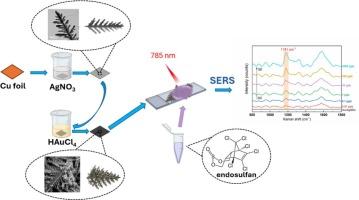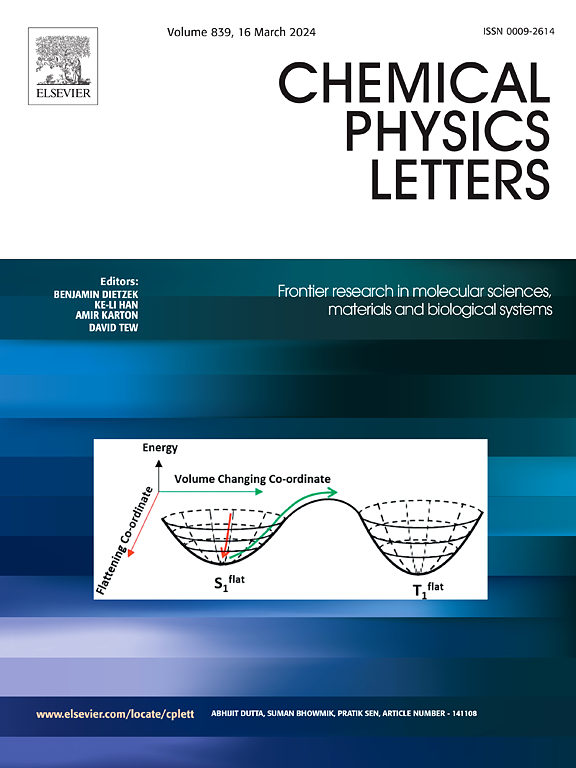快速有效地合成蕨类银纳米树突修饰金纳米粒子以提高硫丹的SERS检测
IF 3.1
3区 化学
Q3 CHEMISTRY, PHYSICAL
引用次数: 0
摘要
表面增强拉曼散射(SERS)纳米衬底的发展是研究的一个关键目标,重点是提高灵敏度和简化制造。本研究提出了一种在室温下通过氧化还原过程合成金/银纳米枝晶(Au/AgNDs)的简单方法,可以在几分钟内快速生成高度支化的纳米结构,而无需额外的溶剂、还原剂或稳定剂。此外,通过系统地改变前体的浓度和反应时间,可以产生不同形态的AgNDs。粗糙的Au/AgNDs表面提供了高密度的电磁位点,这有利于使用SERS技术进行分子分析。根据反应时间、试剂浓度、温度等条件,选择分支长度为1.0 ~ 10 μm的agnd进行金纳米颗粒修饰。对Au/AgNDs底物检测硫丹的有效性进行了评价,在5种底物的18个随机测量点(每个底物至少检测4个点)上,检测限(LOD)为0.087 ppb,定量限(LOQ)为0.284 ppb,相对标准偏差(RSD)为5.61%,重复性好。FDTD方法模拟了Au/AgNDs上的电磁场,支持了这些纳米材料增强SERS能力的纯理论研究结果。这些结果表明,Au/ agnd是潜在的化学传感和环境监测的SERS底物。本文章由计算机程序翻译,如有差异,请以英文原文为准。

Rapid and effective synthesis of fern-shaped silver nanodendrites decorated with gold nanoparticles to improve SERS detection of endosulfan
The advancement of surface-enhanced Raman scattering (SERS) nanosubstrates is a key goal in research, focusing on improving sensitivity and simplifying fabrication. This study presents a simple method for synthesizing gold/silver nanodendrites (Au/AgNDs) via a redox process at room temperature, enabling the rapid production of highly branched nanostructures in minutes without the need for additional solvents, reducing agents, or stabilizers. Furthermore, by systematically varying the concentration of precursors and the reaction time, it is possible to produce different morphologies for AgNDs. The rough Au/AgNDs surface provides a high density of electromagnetic sites, which benefits molecular analysis using SERS techniques. AgNDs with branch lengths ranging from 1.0 to 10 μm were selected for gold nanoparticle decoration based on governing conditions, including reaction time, reagent concentrations, and temperature. The effectiveness of the Au/AgNDs substrate in detecting endosulfan was evaluated, showing a detection limit (LOD) of 0.087 ppb, quantification limit (LOQ) of 0.284 ppb, and a percentage relative standard deviation (RSD) of 5.61 % based on 18 random measurement locations across five substrates with at least 4 points tested per substrate, indicating good reproducibility. The FDTD method simulated the EM fields on Au/AgNDs, supporting the purely theoretical findings about the ability of these nanomaterials to enhance SERS. These results show that Au/AgNDs are potential SERS substrates for chemical sensing and environmental monitoring.
求助全文
通过发布文献求助,成功后即可免费获取论文全文。
去求助
来源期刊

Chemical Physics Letters
化学-物理:原子、分子和化学物理
CiteScore
5.70
自引率
3.60%
发文量
798
审稿时长
33 days
期刊介绍:
Chemical Physics Letters has an open access mirror journal, Chemical Physics Letters: X, sharing the same aims and scope, editorial team, submission system and rigorous peer review.
Chemical Physics Letters publishes brief reports on molecules, interfaces, condensed phases, nanomaterials and nanostructures, polymers, biomolecular systems, and energy conversion and storage.
Criteria for publication are quality, urgency and impact. Further, experimental results reported in the journal have direct relevance for theory, and theoretical developments or non-routine computations relate directly to experiment. Manuscripts must satisfy these criteria and should not be minor extensions of previous work.
 求助内容:
求助内容: 应助结果提醒方式:
应助结果提醒方式:


